COMMERCIAL BREAD RECIPE | COCONUT BREAD RECIPE| NIGERIA AGEGE BREAD RECIPE
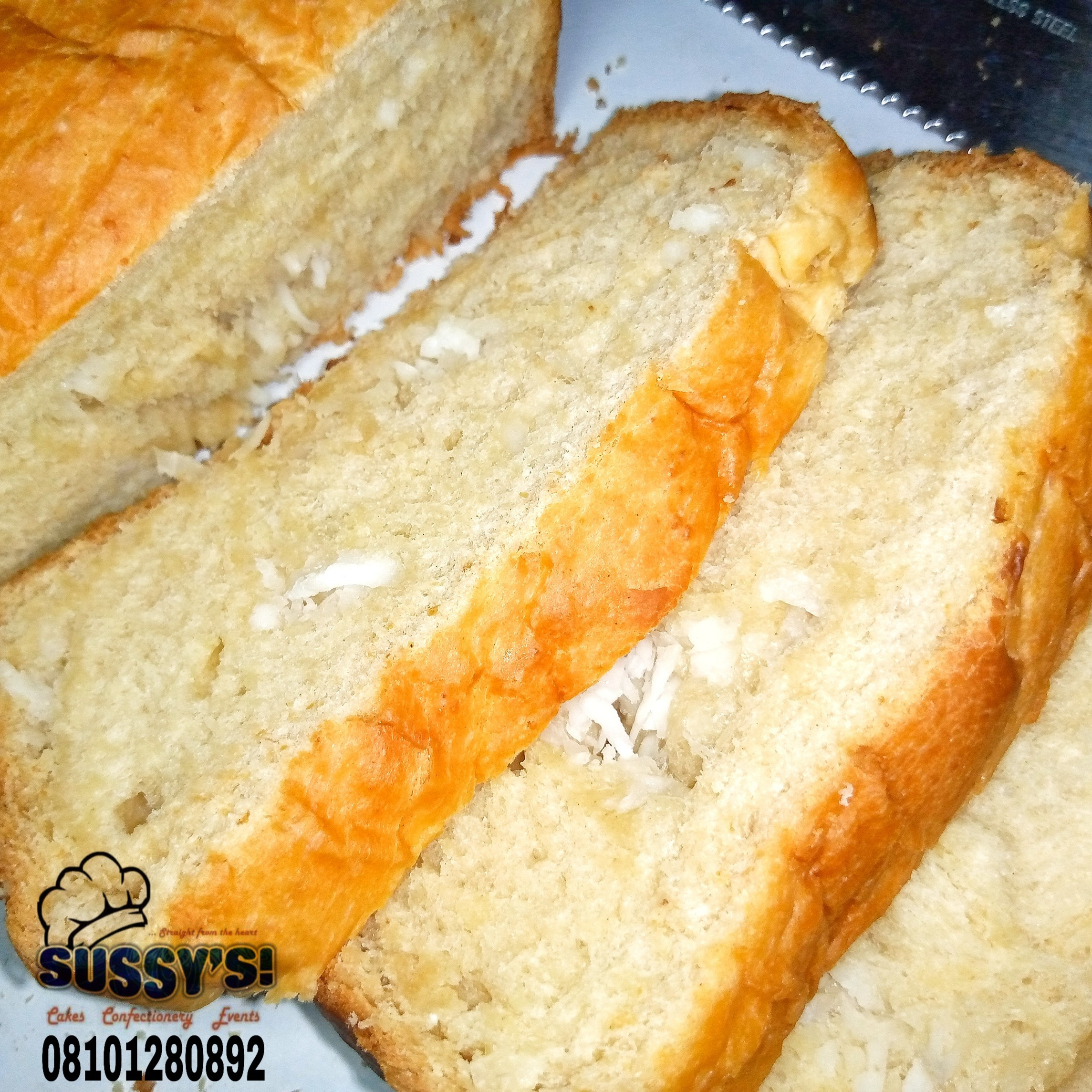
On my YOUTUBE CHANNEL, I hit 1000 subscribers recently and I promised prior to now that I would share my most anticipated Commercial bread recipe, or what we in Nigeria know as ‘Nigeria bread’ or ‘Agege bread’. Well, I would be making an executive version 😂. Oh yes! This is that version that strikes the balance between a regular commercial bread and a delicious and easy homemade bread. And that’s also why this bread recipe is in two ways. It’s first a Commercial Nigeria Bread recipe and also a Coconut Bread recipe! In this recipe I will also be sharing pro tips and secrets no one told you about bread making!
Just like my SOFTEST DINNER ROLLS recipe, this is definitely another no-fail recipe. However unlike my NO KNEAD SARDINE BREAD recipe, this Commercial Bread recipe will require all the strength you need if you don’t have a Commercial bread mixer. This shouldn’t get you discouraged though, ‘cos I will show you how easy I knead my bread and yeast raised recipes.
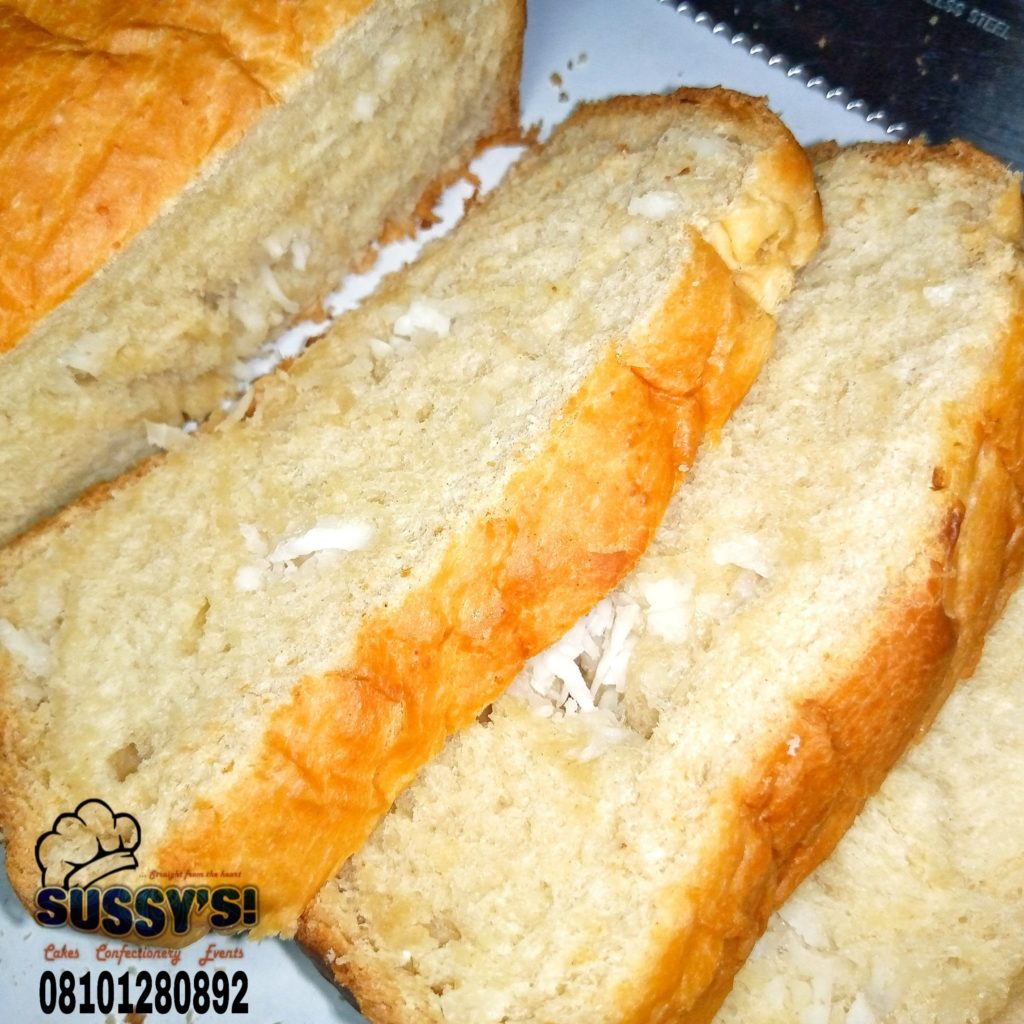
CHARACTERISTICS OF A GOOD BREAD:
- A good bread in my honest opinion should have a nice, crispy crust. This ensures you have a nice tasting experience.
- A great bread should have ‘air pockets’. I usually tell people that bread dough requires lots of kneading, but even at that, do not over work your dough. Over working your dough will produce dense breads. Your bread should posses bubble sizes of air pocket. I will work you through the process of ensuring you don’t over knead your dough.
- Finally flavor. A great bread should have a good flavor even before you bite into it.
WHAT INGREDIENTS ARE IN COMMERCIAL BREAD?
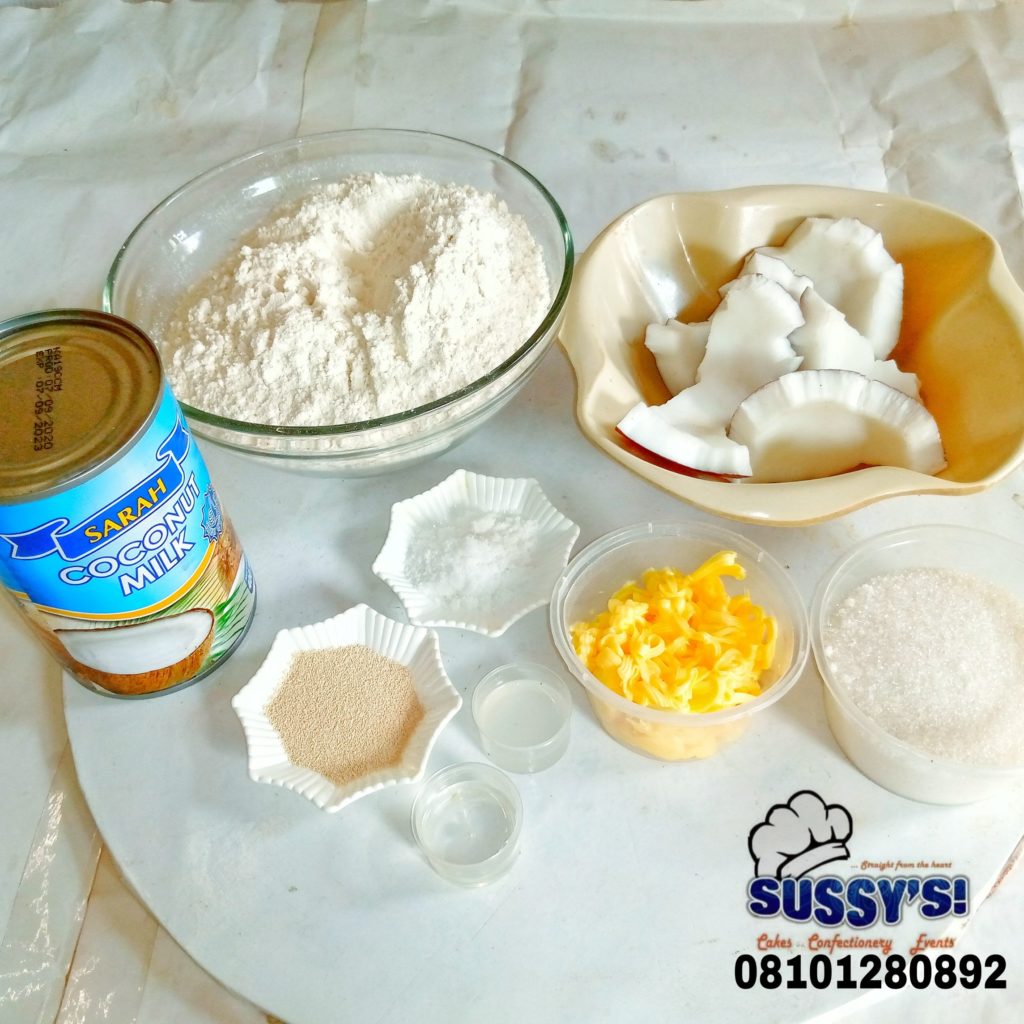
Or let me rephrase that subtitle to ‘What ingredients are in MY commercial bread?’. Better.
Basically the ingredients in any commercial bread are Flour, Liquid, Salt, and Yeast. But the ingredients in my own executive Commercial Coconut Bread Recipe differs. So I am going to explain each.
- Let’s start with FLOUR. Recently, in one of my livestream on my Youtube channel, I spoke about Flour and the types we have. I won’t bore you with details here as you can check the LIVESTREAM to join the discussion. For my commercial bread recipe, I made use of your regular all-purpose Flour as against some recipes that will call for Bread flour. Bread flour contains more gluten than all-purpose flour. Considering the fact that most of us homebakers might not have access to bread flour, I decided to use a flour type available in your general market.
- Next is Yeast. For all my yeast raised doughs and recipes, I use ‘instant dry yeast’. Make sure you’re using a good brand. Yeast leavens the bread dough. Also make sure you stick to the quantity stated in my recipe. Too much yeast will cause bread to rise quickly and also give a funny smell. I use instant dry yeast because with this you do not need to dissolve first in warm water before using.
- Salt: It regulates the action of the yeast and restrain the action of a certain enzymes in the flour. Omitting salt will produce sticky dough that would be hard to handle.
- LIQUID : For my bread recipes, I try as much as possible to use either milk or 50% milk and 50% water. The addition of milk adds more richness to your dough. And since this is a coconut commercial bread recipe, I used Coconut milk. Now you can feel free to use just water. But if you want a rich bread, then do well to use milk. You can use any brand of evaporated milk or whole full cream milk. You can also use 50% milk and 50% water. One thing I want to warn you in advance is that milk reduces the shelf life of any baked treat. So if for instance your regular bread shelf life is 4 day, when you use milk as the liquid, shelf life will reduce to 2 days. So for me, I wanted to maintain the Coconut flavour, hence I used Coconut Milk.
- Sugar: As discussed in one of my livestream, sugar doesn’t just make your treats sweet. It plays a number of function. And in yeast doughs, sugar gives the yeast extra food to rise quickly. This should not make you increase the quantity of sugar in my recipe please 😂. Too much sugar will slow the proofing process. Sugar will also influence the browning, flavor, and texture of the bread.
- Fat: For fat, I made use of margarine . Your regular commercial Agege bread recipe uses margarine, so I am sticking to it in this recipe. If you alter my recipe by using melted margarine for instance, you will have a totally different result. Fat in whatever form adds extra tenderness to your bread. Use a good brand of margarine.
- Coconut Flakes or Shredded Coconuts: Since this is an executive coconut bread recipe, it won’t be complete without some coconut flakes. For an all-white bread texture, you would want to scrape off the brown part off your coconut and use your freshly grated coconut. I find this juicer in my own terms than when you use dessicated coconut flakes. For coconut flakes, you can decide to buy or make yours. To make yours simply grate your coconut, spread them on a lined baking tray of a non-sticky Pan and toast them in an oven (preheated or not) till slightly dry and brown in colour. You can also use a dehydrator. If using a Pan, place Pan over stove and stir continuously till flakes are a bit dry. If you don’t want to make it into a coconut bread, and just want to make a regular commercial bread, then omit the Coconut Flakes, Coconut Flavor, and Coconut Milk (use ordinary milk or water or both as discussed earlier)
- Coconut flavour: If I am not making a coconut version of this bread, I usually would not add any flavor. But because this is a Commercial Coconut Bread recipe, I added coconut flavor.
- Now for the one thing that defines the regular commercial bread, or Nigeria bread, or Agege bread as we call it here – DOUGH CONDITIONER/DOUGH IMPROVER/DOUGH ENHANCER. All these are different terms which means the same thing. I am going to be explaining this in details. I will talk about the commercial ones (confectionery’s additive / chemicals) and I will talk about the natural ones (the ones you can use if you want to keep it homemade and safe).
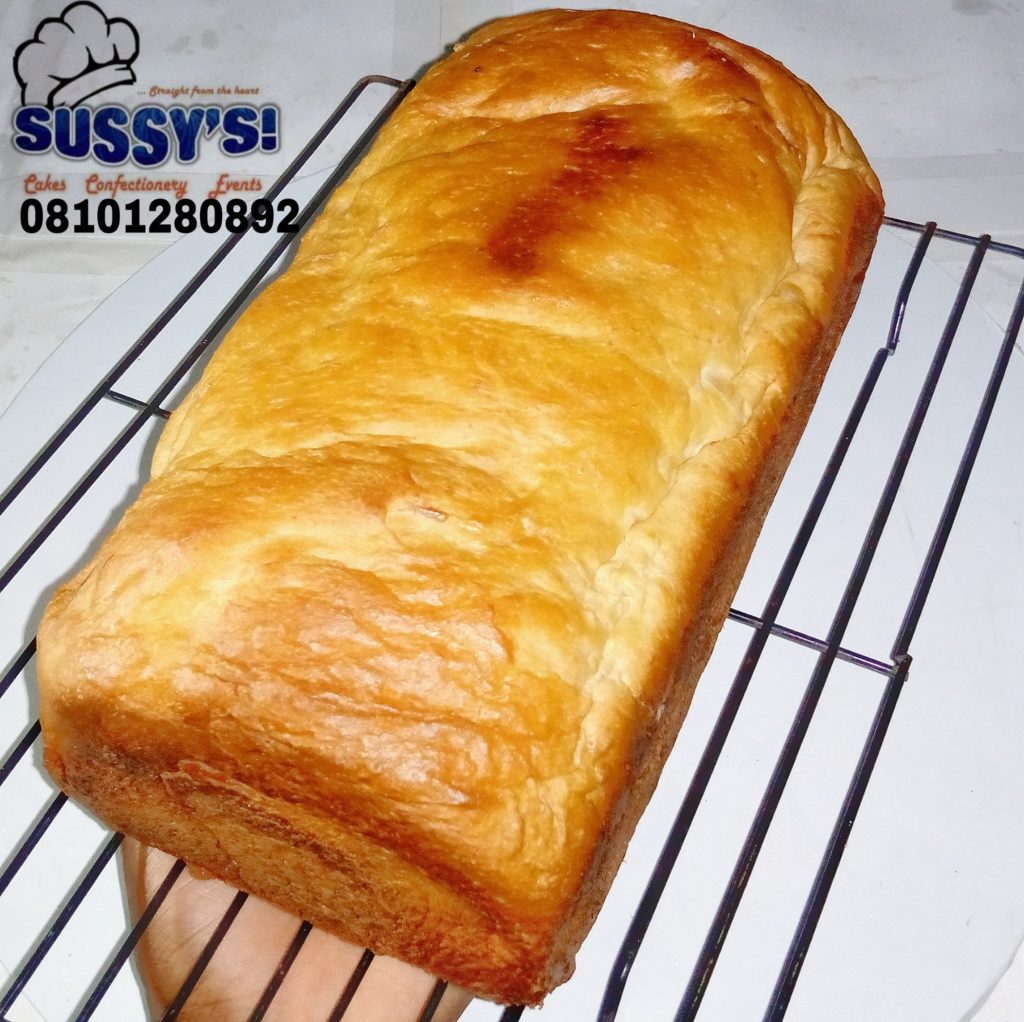
What is a Dough Conditioner?
Dough conditioner is any baking ingredient that improves the production and consistency of a dough.
What are the benefits of a Dough Conditioner?
- Dough conditioner helps to reduce the rising and proofing process to save time and effort in the bread-making process.
- Makes the dough easier to manage and more tolerant to handle.
- Dough improver / conditional improves the environment and nutrients in the dough to promote yeast growth.
- Increases the gas production of yeast and gas retention by the gluten.
- It provides more consistent results.
- It compensates for flour quality variations and external variables. This usually occurs when you use a different flour type apart from what’s stated in your recipe.
- It strengthens the gluten structure to create a better crumb texture and chewy texture.
- Increases the volume of the bread without extra proofing time.
- It improves the crust development and color of your bread.
- Increases the overall bread yields from the dough batch; keeps the bread fresh for longer; and delays the staling of the bread.
Now that you know what dough conditioner/dough enhancer /dough improver is ; let me say there are commercial dough enhancer used by commercial bakeries that produces a consistent taste, unique stretchy texture, and flavor. We call it EDC (EDLEN DOUGH CONDITIONER) / Ascorbic acid (vitamin C). Then what’s used to preserve their bread is Calcium propionate – useful in extending the shelf life of bread by preventing all forms of microbial growth in the bread. You would see them in this terms Edc 2000, E-281, and E-202.
These chemicals or confectionery additives and preservatives are termed ‘safe to eat’ but are not healthy. Oops did I break your heart? Don’t worry, I can fix it 😂.. So you now know the components of what goes into your regular ‘Commercial bread / Agege bread / Nigeria bread’. This is the reason I usually stick to naturally, healthy dough enhancer for my homemade breads. But for the purpose of this recipe I had to use EDC.
EDC could be in liquid form like I used in my video or in powdered form. The powdered or liquid form performs the same function. The liquid form looks like vinegar but thicker. You can get it from baking stalls or those who sell bread items (best bet!). For the powered ones, just add it to your dry items and continue with the recipe, while for the liquid ones, add to your wet item. Like I said it is safe to eat but it is not what I will call healthy.
Enough of all the chemicals and confectionery additives, let’s go natural and healthy! Are there natural Dough Enhancer/Dough improver/Dough Conditioner? The answer is YES! Do they perform same job as their commercial counterparts? The answer is YES! Now I fixed your heart right? 😀. But should you open a bakery using this natural dough conditioner? NO. (I can’t explain this here. I did a detailed explanation of this in my BREAD CLASS).
So what are these Natural Dough Conditioner?
- Sugar: Yes sugar. Sugar acts as a natural preservative in your baked item.
- Scalded Flour: is a natural dough improver used by the Scandinavian to boost the texture and taste of their breads. It has the same function like Tanzhong but the difference is in the way both dough conditioners are prepared. To prepare this, you will need equal amount of flour (plain flour or bread flour) and boiling water. E.g 50g of flour and 50ml of boiling water. Then pour the boiling water into the flour and stir quickly to combine well and cover your bowl with a cling film or plastic wrap till mixture cools completely. It’s mostly left for 12 hours before using. I think I would have to write a separate article on this.
- Tangzhong (Water roux) : This dough conditioner is peculiar to the Japanese. In my SOFTEST and FLUFFIEST CHINESE SAUSAGE BREAD, I made use of this Water roux. It is a starter used to achieve a soft, and stretchy dough. It is also a natural preservative that can keep your bread fresh for up to 4 days! I promise to write am article on it soonest.
- Apple Cider Vinegar or Distilled White Vinegar : To use, use same measurement like yeast in your recipe. That is if the measurement of yeast in your recipe is 20g, you are using 20ml of Vinegar.
- Ginger : I once shared this on my PERSONAL FACEBOOK PAGE that Ginger is a good natural dough enhancer. I was surprised that most people didn’t know. Adding ¼ tsp of powdered ginger per bread loaf works magic! And no your bread won’t taste like ginger!
- Dry Milk Powder: Dry milk powder will help your bread rise higher, stay soft, and hold the moisture longer. That means it won’t get stale quickly. Dry milk powder creates a more golden brown crust and improves nutrition. Use 2 tablespoon of instant dry milk powder per bread loaf. I would stop here and elaborate more in my next article about Natural Dough Conditioners.
HOW TO FOLD YOUR COMMERCIAL BREAD/COCONUT BREAD / NIGERIA AGEGE BREAD:
It is one thing to have a good bread recipe and use good ingredients, but it’s another thing to fold your bread dough well. The way you fold your bread will determine if they will come out well with nice air pockets and texture. So I will share one of my bread folding methods using this pictorial below.
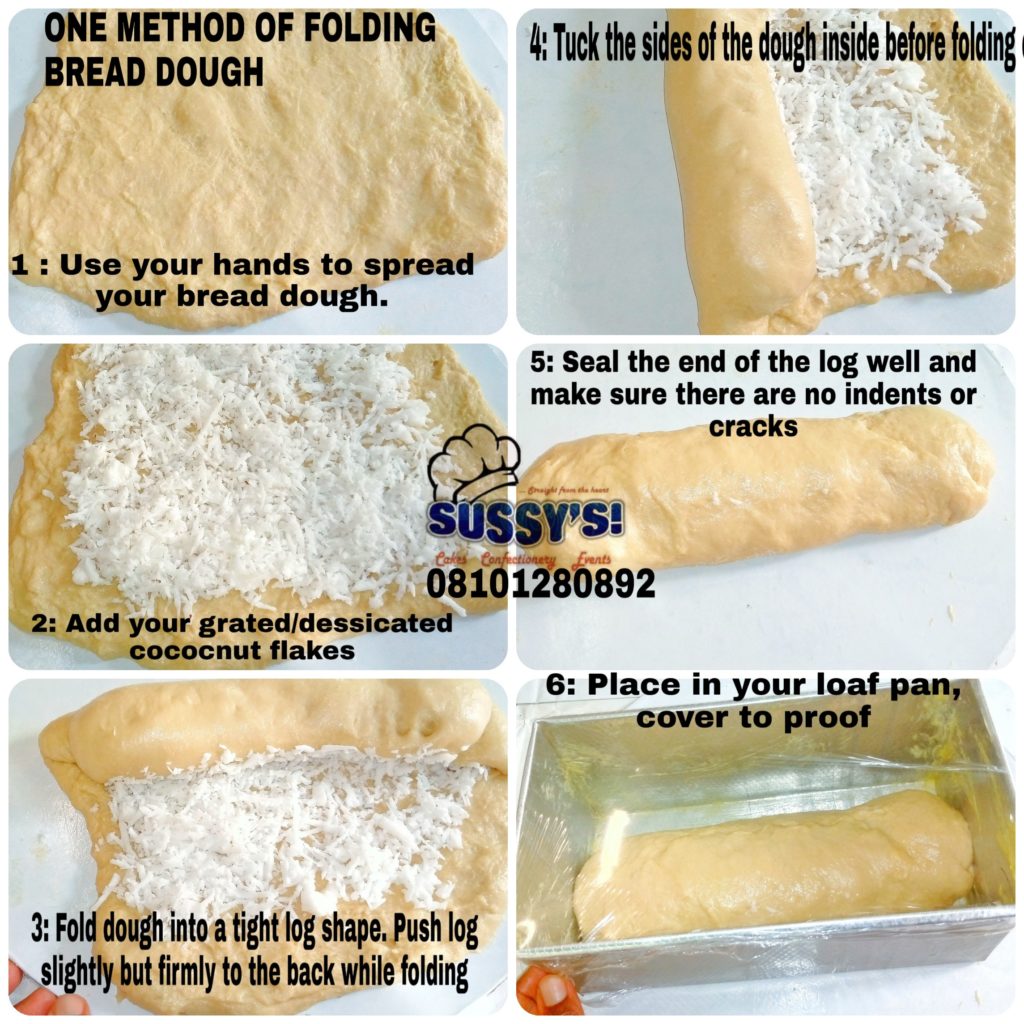
GENERAL TIPS FOR MAKING THE BEST COMMERCIAL BREAD / COCONUT BREAD/ NIGERIA BREAD / AGEGE BREAD:
- Follow my step-by-step process for the same result as mine. I don’t think we need to over emphasize this.
- Always use the best ingredients.
- Use a stop watch. Get a timer. Get a clock.
- Use the best brand of Instant dry yeast. Store your yeast properly. In my bread class, I taught intensively on how to store Yeast and how to handle yeast without fear.
- Knead your dough well. If using a commercial stand mixer, you will want to knead for 8 – 10 minutes. And if using your hands, use the slamming method as shown in the video to knead for 15 minutes at a stretch.
- Do not overwork your dough. You will end up with hardened dough.
- Want to make your bread healthy? Then ditch all chemicals and commercial/confectionery additives and use natural dough enhancer.
- Don’t over proof your bread dough.
- Don’t overbake your bread.
- Fold your bread properly. Don’t use your rolling pin to spread out your bread dough please.
- Don’t add flour to your work surface while kneading by hand. You don’t want to end up with hardened bread.
- Bread needs hot oven, so make sure to heat up your oven well for at least 20 minutes before baking. Don’t be in a hurry. This isn’t a pastry but a yeast raised dough.
- Create steam in your oven when baking bread : This is one of my most treasured bread making secret. The steam encourages “oven spring” which makes taller, lighter loaves of bread. It also crisps the crust and makes the crust chewier. You can create steam in your oven while baking, by putting a heavy pan (frying pan), onto the bottom rack of your oven. Just before you put your loaves into the oven to bake, pour boiling water into the frying pan. Add your loaf pans and close the oven door. This is what I do. Another way to create steam is to lightly spritz the oven walls with water, avoiding the oven light / fire, at the beginning of the baking period. You can do this effectively by using a spray bottle.
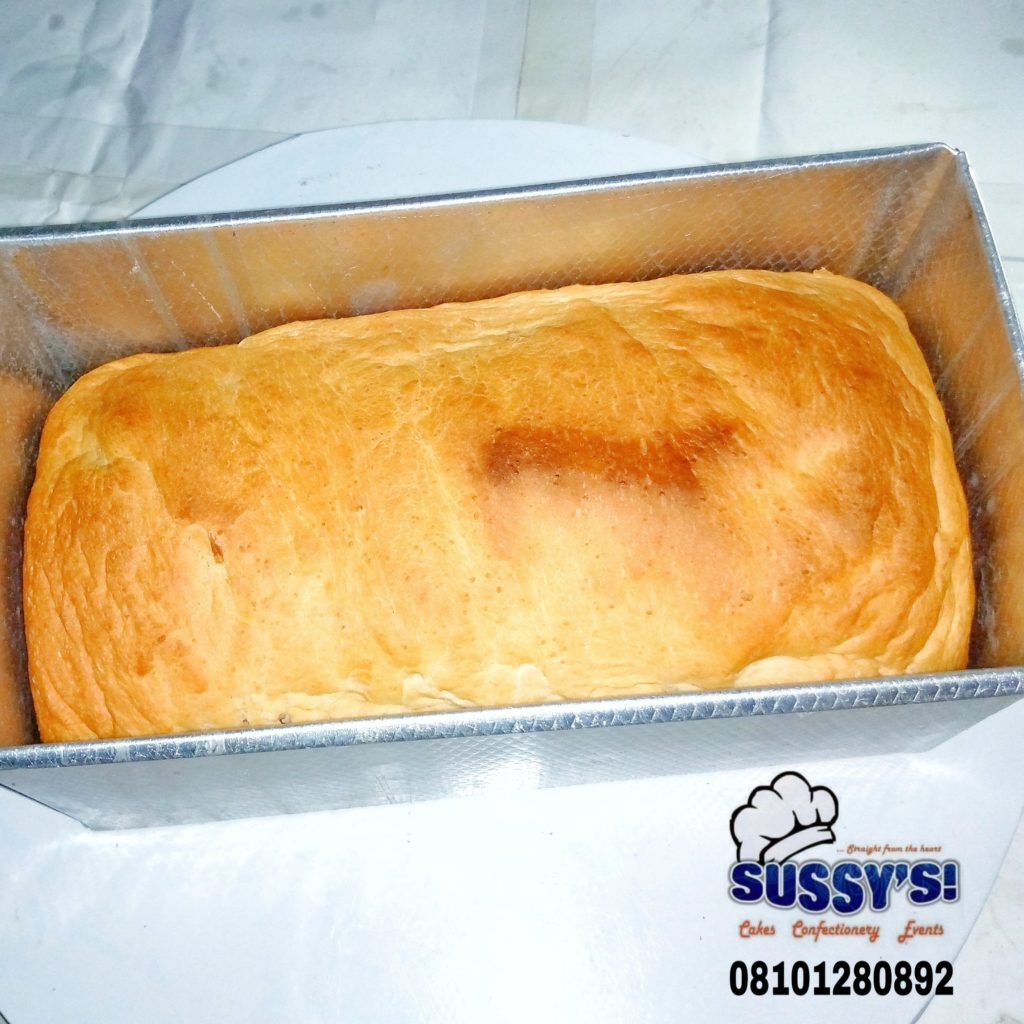
BREAD COOLING TIPS:
Cooling your bread is the last important step in bread making . Bread should be allowed to cool until it has reached body temperature before slicing to allow the interior to set. You can eat bread straight from the oven, but it is not fully developed in terms of flavor and texture. You might also struggle to cut the bread because the inside is still very wet and gummy. Bread takes so long to cool because it is initially still cooking when it comes out of the oven. This simply means that the bread is still very hot inside and contains lots of steam.
The reason we need to cool bread before slicing is because the cooling period is important in finishing the development of the crumb. It’s also important for storage as we need to allow it to cool and dry before we cover it up otherwise you will see mold form.
There are two ways you can cool your bread. Always remember while cooling your bread that the main goal is to allow air to circulate around the bottom and stop the underside from steaming itself and becoming soggy. The first method is to place it on a wire rack so that air can circulate fully. And the second method is to turn the bread on its side so that the base of the bread is not touching the worktop. You should not cover bread while it is cooling. When the bread is cooling, water is evaporating from the interior crumb.
So finally, let’s get started with making Commercial Bread / Coconut Bread/ Nigerian Agege Bread Recipe:
- Measure out all items and keep on your work surface where you can see them. Grease your bread loaf Pan with margarine and set aside.
- Get your Coconut, break it, and remove from shell, wash it. Scrap of off the brown part, if making an all-white bread. Then grate it, measure, and put in a strainer to strain off any remaining water. Set aside. If you want to make dessicated coconut flakes, simply grate your coconut, spread them on a lined baking tray of a non-sticky Pan and toast them in an oven (preheated or not) till slightly dry and brown in colour. You can also use a dehydrator. If using a Pan, place Pan over stove and stir continuously till flakes are a bit dry.
- In a large mixing bowl start by adding your dry items EXCEPT COCONUT FLAKES / SHREDDED COCONUT (flour, sugar, salt) stir. If using powdered EDC add it now. Then stir. Next add your yeast. Salt and Yeast should be added at different portion of your bowl or at different intervals to prevent salt from killing your yeast. Stir to combine.
- Next create a hole in the middle of your dry items, add your coconut flavor and if using liquid EDC like I am using here, add it now. Stir. (You can’t use both liquid and dry EDC you can only use one; either dry or liquid). If using any of my above listed natural dough conditioner, add the wet conditioner like scaled flour, water roux and vinegar, to wet item and dry dough conditioner like powder ginger and milk powder to dry items. (Just like the commercial additives and preservatives, you can’t use both. You can only use one of any of the dough conditioner forms).
- Now start adding your milk or water little by little. If using 50% milk and 50% water, add them alternatively. Add gradually till you get a non sticky, rough looking dough. Flour types and brands differ and each absorbs liquid differently. So you might end up using the whole milk in the recipe and you might not.
- Now it’s time to knead. If using a Commercial Bread mixer now it’s time to put that bread dough in it. Please use a very good commercial bread mixer. I have a trusted VENDOR who sells good lasting Industrial Bread Mixers and other Industrial Equipments that’s perfect for your bakery setup or kitchen use. Using the dough hook attachment of your Stand Mixer, knead first for 3 minutes, then add your margarine and continue kneading on medium speed for 7 minutes.
- While if using your hands like I did, you will want to use the ‘slamming method’. And slam first for 5 minutes, then add your margarine. This will be messy but don’t worry. Get a bench scraper and use it to gather the dough together and knead in the margarine till well incorporated. Then start slamming on your work surface for 10 minutes at a stretch.
- At the end of your preferred kneading method, your dough should be smooth, stretchy and hold its shape for some seconds before tearing (this is the lamination method used to check if your dough is ready). Another way to check is by pressing the dough with your index finger. If it’s well kneaded, your finger won’t stick. Also the dough will be smooth and soft.
- Then place your bread dough on your work surface and using your fingers, spread it into a rectangular shape. See pictorial above for details. Don’t use your rolling pin. Now add your Coconut Flakes / Shredded strained Coconut, and fold like in the pictorial. Make sure to use your bread loaf Pan as a guide.
- Place folded bread into your Pan, cover Pan with cling film or plastic wrap and allow bread proof for an hour(1 hour). 20 minutes to the end of this proofing period, preheat your oven.
- At the end of this proof period, if you want a bread with flat top, grease the Pan’s lid with odourless oil or margarine and cover the bread loaf Pan. If however you don’t care for a flat top, just ignore. (But covering the top of your bread pan creates steam for the bread while baking amongst other benefits). Be careful of how you handle the bread at this stage so you don’t end up deflating your proofed bread.
- Now place bread in a 180°C preheated oven and bake for 25-30minutes. To test for doneness, your bread will be golden brown when you remove it from the oven. Also when you tap the top of the bread, you will hear a hollow sound. This shows your bread is baked. Your whole bakery or kitchen should be filled with the aroma of freshly baked bread by now.
- Allow bread to almost cool in the Pan (at least 80%), then turn over to a rack to cool completely. Slice bread with a serrated knife, spread with your favorite butter brand, or spread, or eat plain Enjoy!

COMMERCIAL BREAD RECIPE | COCONUT BREAD RECIPE| NIGERIA AGEGE BREAD RECIPE
Equipment
- Mixing Bowls
- Industrial Stand Mixer
- Loaf Pan
- Oven
- Cooking rack
- Serrated Knife
Ingredients
- 300 grams all-purpose Flour
- 100 grams granulated white Sugar
- 8 grams Salt
- 5 grams Yeast Instant dry yeast
- 50 grams Margarine
- 5 grams EDC (Dough Enhancer)
- 100 grams Coconut flakes or shreds
- 1 cup Coconut Milk (234ml) or water
- 1 tsp Coconut flavour
Instructions
- Measure out all items and keep on your work surface where you can see them. Grease your bread loaf Pan with margarine and set aside.
- Get your Coconut, break it, and remove from shell, wash it. Scrap of off the brown part, if making an all-white bread. Then grate it, measure, and put in a strainer to strain off any remaining water. Set aside. If you want to make dessicated coconut flakes, simply grate your coconut, spread them on a lined baking tray of a non-sticky Pan and toast them in an oven (preheated or not) till slightly dry and brown in colour. You can also use a dehydrator. If using a Pan, place Pan over stove and stir continuously till flakes are a bit dry.
- In a large mixing bowl start by adding your dry items EXCEPT COCONUT FLAKES / SHREDDED COCONUT (flour, sugar, salt) stir. If using powdered EDC add it now. Then stir. Next add your yeast. Salt and Yeast should be added at different portion of your bowl or at different intervals to prevent salt from killing your yeast. Stir to combine.
- Next create a hole in the middle of your dry items, add your coconut flavor and if using liquid EDC like I am using here, add it now. Stir. (You can't use both liquid and dry EDC you can only use one; either dry or liquid). If using any of my above listed natural dough conditioner, add the wet conditioner like scaled flour, water roux and vinegar, to wet item and dry dough conditioner like powder ginger and milk powder to dry items. (Just like the commercial additives and preservatives, you can't use both. You can only use one of any of the dough conditioner forms).
- Now start adding your milk or water little by little. If using 50% milk and 50% water, add them alternatively. Add gradually till you get a non sticky, rough looking dough. Flour types and brands differ and each absorbs liquid differently. So you might end up using the whole milk in the recipe and you might not.
- Now it's time to knead. If using a Commercial Bread mixer now it's time to put that bread dough in it. Please use a very good commercial bread mixer. I have a trusted VENDOR who sells good lasting Industrial Bread Mixers and other Industrial Equipments that's perfect for your bakery setup or kitchen use. Using the dough hook attachment of your Stand Mixer, knead first for 3 minutes, then add your margarine and continue kneading on medium speed for 7 minutes.
- While if using your hands like I did, you will want to use the 'slamming method'. And slam first for 5 minutes, then add your margarine. This will be messy but don't worry. Get a bench scraper and use it to gather the dough together and knead in the margarine till well incorporated. Then start slamming on your work surface for 10 minutes at a stretch.
- At the end of your preferred kneading method, your dough should be smooth, stretchy and hold its shape for some seconds before tearing (this is the lamination method used to check if your dough is ready). Another way to check is by pressing the dough with your index finger. If it's well kneaded, your finger won't stick. Also the dough will be smooth and soft.
- Then place your bread dough on your work surface and using your fingers, spread it into a rectangular shape. See pictorial above for details. Don't use your rolling pin. Now add your Coconut Flakes / Shredded strained Coconut, and fold like in the pictorial. Make sure to use your bread loaf Pan as a guide.
- Place folded bread into your Pan, cover Pan with cling film or plastic wrap and allow bread proof for an hour(1 hour). 20 minutes to the end of this proofing period, preheat your oven.
- At the end of this proof period, if you want a bread with flat top, grease the Pan's lid with odourless oil or margarine and cover the bread loaf Pan. If however you don't care for a flat top, just ignore. (But covering the top of your bread pan creates steam for the bread while baking amongst other benefits). Be careful of how you handle the bread at this stage so you don't end up deflating your proofed bread.
- Now place bread in a 180°C preheated oven and bake for 25-30minutes. To test for doneness, your bread will be golden brown when you remove it from the oven. Also when you tap the top of the bread, you will hear a hollow sound. This shows your bread is baked. Your whole bakery or kitchen should be filled with the aroma of freshly baked bread by now.
- Allow bread to almost cool in the Pan (at least 80%), then turn over to a rack to cool completely. Slice bread with a serrated knife, spread with your favorite butter brand, or spread, or eat plain Enjoy!
Video
If you liked this recipe, kindly leave me a reaction 💖. This will encourage me to create more no-fail homemade simple recipes! Also use the share button to share the recipe. Thank you.
Sussan apeh
To sign up for my BREAD CLASS either online that runs 24/7 or on-site please send me a direct message via email or through any of my social media platform.
Remember to always tag us to your creation using #sussycakesrecipes
I love to see your feedback and creation!
Nutrition Facts
2 servings per container
- Amount Per ServingCalories1382
- % Daily Value *
- Total Fat
67.2g
104%
- Saturated Fat 43.7g 219%
- Cholesterol 0mg 0%
- Sodium 1820mg 76%
- Potassium 715mg 21%
- Total Carbohydrate
181.4g
61%
- Dietary Fiber 11.9g 48%
- Sugars 58.2g
- Protein 21.3g 43%
- Calcium 53%
- Iron 16%
* The % Daily Value tells you how much a nutrient in a serving of food contributes to a daily diet. 2,000 calories a day is used for general nutrition advice.

Hello, thank you so much for this. In your teaching, I noted you made mention of calcium propionate but it was not included in your recipe. Should it be left our or it is not necessary for commercial bread?
Hello, when making commercial bread to sell, it is necessary to add it. But when making it for family and friends like I did here, it becomes unnecessary. And that’s why I didn’t use it in my recipe.
Thank you for the support
[…] my COMMERCIAL NIGERIA AGEGE BREAD RECIPE, I did a brief introduction into what a dough conditioner is, how to use, etc. In today’s […]